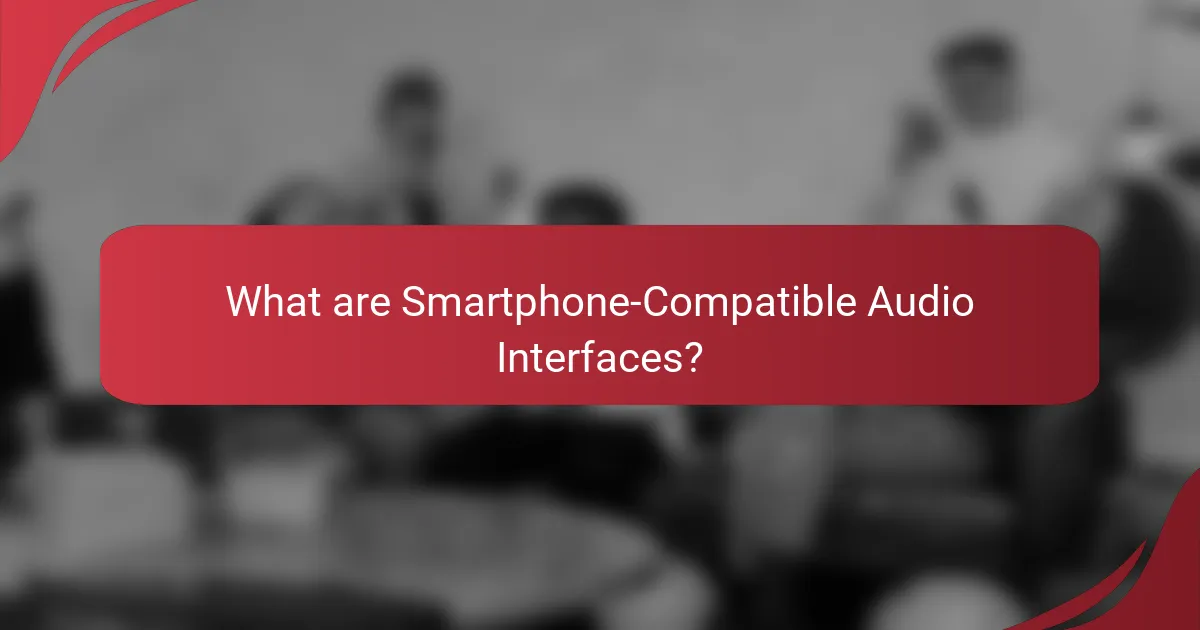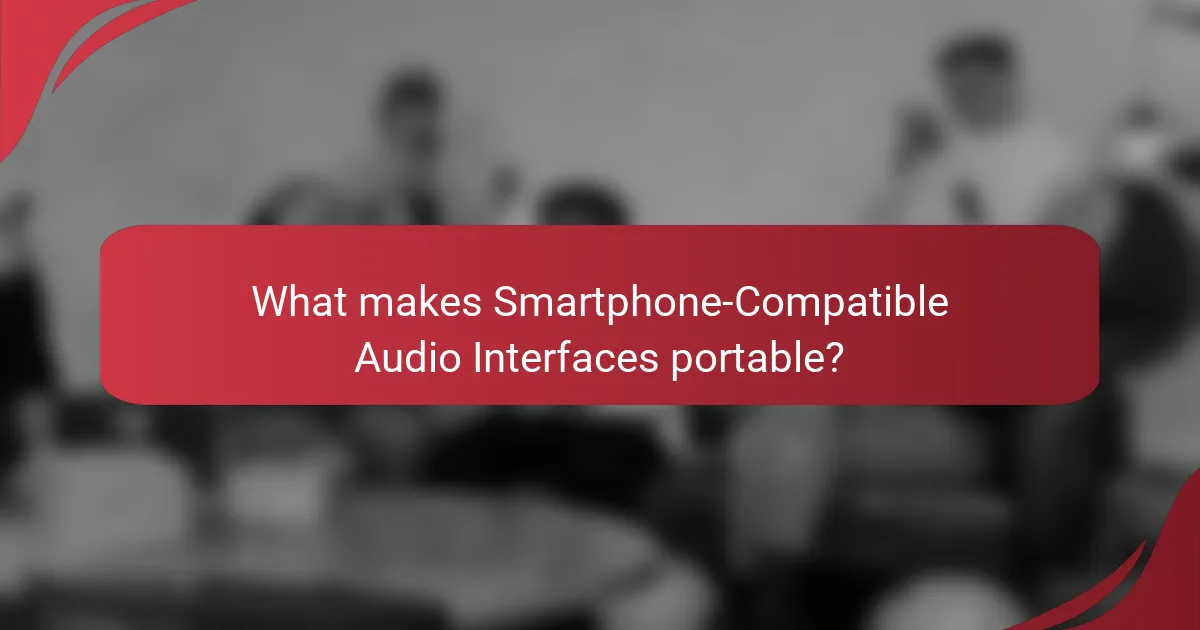Smartphone-compatible audio interfaces are devices that connect microphones and instruments to smartphones, facilitating high-quality audio recording and playback. These interfaces typically utilize USB, Lightning, or Bluetooth connections, ensuring compatibility across various smartphone brands and operating systems. Key features include preamps, phantom power, and monitoring outputs, enhancing audio capabilities for mobile musicians and podcasters. Their compact and portable design, often battery-powered, allows for easy transport and on-the-go use. As mobile music production grows in popularity, the demand for these interfaces continues to rise, with brands like Focusrite and IK Multimedia offering a range of models to meet user needs.

What are Smartphone-Compatible Audio Interfaces?
Smartphone-compatible audio interfaces are devices designed to connect microphones and instruments to smartphones. They enable high-quality audio recording and playback. These interfaces typically use USB or Lightning connections for compatibility. They often include features like preamps, phantom power, and monitoring outputs. The growing popularity of mobile music production has increased their demand. Brands like Focusrite and IK Multimedia offer various models. Many interfaces are compact and portable, making them ideal for on-the-go use. Their functionality enhances the audio capabilities of smartphones significantly.
How do Smartphone-Compatible Audio Interfaces function?
Smartphone-compatible audio interfaces function by converting analog audio signals into digital data. This process allows musicians and audio professionals to connect microphones and instruments to smartphones. The interface typically features inputs for audio sources and outputs for headphones or speakers. It connects to smartphones via USB or Lightning ports, ensuring compatibility.
The device often includes preamps to boost signal levels. Some interfaces also provide phantom power for condenser microphones. Digital signal processing may be integrated, enhancing audio quality. This functionality enables high-fidelity recording and playback on mobile devices.
The design prioritizes portability, allowing for easy transport and use in various locations. Many interfaces are compact and lightweight, appealing to on-the-go users. Their functionality supports diverse applications, from music production to podcasting.
What are the key components of these audio interfaces?
The key components of smartphone-compatible audio interfaces include analog-to-digital converters (ADCs), digital-to-analog converters (DACs), preamps, and connectivity options. ADCs convert analog audio signals into digital format for processing. DACs perform the reverse, converting digital audio back into analog signals for playback. Preamps amplify weak audio signals to a usable level. Connectivity options typically include USB, Lightning, or Bluetooth for linking to smartphones. These components work together to ensure high-quality audio input and output in mobile settings.
How do these components interact with smartphones?
Smartphone-compatible audio interfaces interact with smartphones through digital connectivity and audio processing. These interfaces connect via USB or Bluetooth, enabling audio signals to transfer between the device and the smartphone. They often utilize specific drivers or apps to facilitate communication. The smartphone processes audio input from microphones or instruments connected to the interface. This interaction allows for recording, mixing, and playback of high-quality audio. For example, many audio interfaces support multi-channel audio, enhancing the smartphone’s capabilities. Additionally, they can provide low-latency monitoring for real-time audio feedback. This integration broadens the functionality of smartphones for musicians and audio professionals.
What are the main benefits of using Smartphone-Compatible Audio Interfaces?
Smartphone-compatible audio interfaces offer several key benefits. They enhance audio quality by providing professional-grade sound capture. These interfaces enable direct connection to smartphones, facilitating mobile recording. They support various input sources, such as microphones and instruments, increasing versatility. Users can access advanced features like gain control and monitoring. Many models are compact and lightweight, promoting portability. They often use USB or Lightning connections, ensuring broad compatibility. Overall, these interfaces empower musicians and content creators to produce high-quality audio on the go.
How do they enhance audio quality for mobile devices?
They enhance audio quality for mobile devices by utilizing advanced digital-to-analog converters (DACs). These DACs improve sound fidelity by converting digital audio signals into high-quality analog signals. Enhanced signal processing algorithms also reduce noise and distortion. High-resolution audio support allows playback of lossless audio formats. Additionally, built-in equalizers enable users to customize sound profiles. Some interfaces include headphone amplifiers to drive high-impedance headphones effectively. These features collectively contribute to a richer and clearer listening experience on mobile devices.
What advantages do they offer for musicians and content creators?
Smartphone-compatible audio interfaces provide several advantages for musicians and content creators. They offer portability, allowing users to record high-quality audio anywhere. This convenience is essential for on-the-go creativity. Additionally, they feature easy connectivity with smartphones, enabling quick setup and use. Many models support various audio formats, ensuring versatility in recording. These interfaces often come with built-in preamps, improving sound quality significantly. They also facilitate real-time monitoring, which enhances the recording experience. Overall, smartphone-compatible audio interfaces streamline the creative process for musicians and content creators.

How do Smartphone-Compatible Audio Interfaces ensure compatibility?
Smartphone-compatible audio interfaces ensure compatibility through standard connectivity options and software support. They typically use USB, Lightning, or Bluetooth connections to interface with smartphones. These connections allow for easy plug-and-play functionality. Many interfaces also come with dedicated apps that enhance compatibility with different smartphone operating systems.
For instance, interfaces designed for iOS devices utilize Apple’s Lightning connector. Likewise, those for Android devices often employ USB-C connections. The use of universal audio protocols, such as USB Audio Class, further enhances interoperability across devices. This ensures that users can connect their audio interfaces to various smartphone brands without issues.
Additionally, firmware updates are provided to maintain compatibility with the latest smartphone models and operating system updates. This adaptability is essential in a rapidly evolving tech landscape. Overall, these features collectively contribute to seamless user experiences across a range of smartphones.
What types of smartphones are compatible with these interfaces?
Smartphones that are compatible with audio interfaces typically include those running iOS and Android operating systems. iOS devices include iPhone models from the iPhone 5 and later. Android devices must support USB OTG (On-The-Go) functionality for compatibility. Most modern Android smartphones from major manufacturers like Samsung, Google, and OnePlus meet this requirement. Additionally, smartphones with a headphone jack can also connect to audio interfaces using standard audio cables. Compatibility may vary based on the specific audio interface model and its connection type. Always check the manufacturer’s specifications for detailed compatibility information.
How does operating system version affect compatibility?
Operating system version significantly affects compatibility by determining which applications and devices can operate seamlessly. Each version of an operating system introduces new features, security updates, and changes in APIs. These changes can lead to incompatibility with older applications that were designed for previous versions. For instance, an audio interface may require a specific OS version to function correctly. If the OS version is outdated, the interface may not work or may have limited functionality. Additionally, manufacturers often specify minimum OS requirements for their devices. This ensures optimal performance and support for newer technologies. Therefore, using the latest OS version typically enhances compatibility with a wider range of applications and hardware.
What connection types are commonly supported?
Commonly supported connection types for smartphone-compatible audio interfaces include USB, Bluetooth, and 3.5mm audio jacks. USB connections allow for direct digital audio transfer and charging. Bluetooth provides wireless connectivity, enabling mobility and convenience. The 3.5mm audio jack is a standard analog connection for headphones and speakers. Many audio interfaces also support lightning connectors for Apple devices. Each connection type enhances compatibility with various smartphone models and audio equipment. These connections are essential for seamless audio integration in mobile environments.
What considerations should users keep in mind for compatibility?
Users should consider the specific operating system of their smartphone for compatibility. Different audio interfaces may support iOS or Android, but not both. Users should also check the connection type, such as Lightning or USB-C. Compatibility with audio apps is crucial; some interfaces work better with specific software. Additionally, users should verify power requirements; some interfaces need external power while others draw from the smartphone. Lastly, users should consider the audio quality specifications, as these can vary significantly between models.
How do app requirements influence interface functionality?
App requirements directly influence interface functionality by dictating the features and capabilities that must be supported. Specific requirements determine how users interact with the app, impacting layout, navigation, and responsiveness. For instance, if an app requires real-time audio processing, the interface must facilitate low-latency controls. Requirements for compatibility with various devices necessitate adaptive interfaces that can adjust to different screen sizes and resolutions. Additionally, user accessibility requirements lead to the inclusion of features such as voice commands or larger touch targets. These factors collectively shape the overall user experience and performance of the interface.
What role does firmware play in compatibility issues?
Firmware acts as the software interface between hardware components and operating systems. It ensures that devices can communicate effectively with each other. Compatibility issues often arise when firmware versions do not match the requirements of the connected hardware or software. For instance, outdated firmware may lack support for newer protocols or features. This can lead to malfunctioning devices or limited functionality. Regular firmware updates are essential for maintaining compatibility with evolving technologies. Manufacturers often release updates to address known compatibility issues. Therefore, firmware plays a critical role in ensuring seamless operation between devices and systems.

What makes Smartphone-Compatible Audio Interfaces portable?
Smartphone-compatible audio interfaces are portable due to their compact size and lightweight design. Many models are designed to fit easily into a backpack or even a pocket. They often utilize USB or lightning connectors, allowing direct connection to smartphones without the need for additional cables. Battery-powered options enhance portability, eliminating reliance on external power sources. Additionally, their user-friendly interfaces make them convenient for on-the-go recording. The versatility in compatibility with various smartphone operating systems further supports their portability. These attributes collectively make them ideal for mobile musicians and podcasters.
How does size and weight impact portability?
Size and weight significantly impact the portability of smartphone-compatible audio interfaces. Smaller and lighter interfaces are easier to carry, making them more convenient for mobile use. For instance, a device weighing under 1 pound is typically more favorable for musicians on the go. This is especially relevant for live performances or travel, where space and weight constraints exist. Additionally, compact designs often fit better into bags or pockets, enhancing their usability in various settings. Research shows that users prefer devices that can be easily transported without compromising functionality. Thus, the size and weight of audio interfaces play a crucial role in their overall portability and user experience.
What are the most compact designs available?
The most compact designs available for smartphone-compatible audio interfaces include the IK Multimedia iRig Pro I/O and the Focusrite Scarlett Solo. The IK Multimedia iRig Pro I/O measures 4.6 x 1.6 x 1.3 inches. It offers a 24-bit/96 kHz audio resolution. The Focusrite Scarlett Solo has dimensions of 7.68 x 5.4 x 1.8 inches. It also provides 24-bit/192 kHz audio quality. Both interfaces are lightweight and designed for portability. They connect easily to smartphones via USB or Lightning connectors. These designs are ideal for musicians on the go.
How do materials used affect portability and durability?
Materials used in smartphone-compatible audio interfaces significantly influence their portability and durability. Lightweight materials like plastic or aluminum enhance portability by reducing overall weight. Conversely, heavier materials may compromise ease of transport but can improve durability. For instance, aluminum offers better resistance to wear and tear compared to plastic. Additionally, materials with high tensile strength, such as reinforced polymers, can withstand impacts, thus enhancing durability. The choice of materials also affects the interface’s resistance to environmental factors, such as moisture and temperature fluctuations. Interfaces made from water-resistant materials are more durable in various conditions, impacting their longevity. Therefore, selecting the right materials is crucial for balancing portability and durability in audio interfaces.
What features enhance the portability of these audio interfaces?
Compact size enhances the portability of audio interfaces. Smaller dimensions make it easier to transport. Lightweight materials further reduce the overall weight. Battery-powered options allow for use without a power outlet. USB connectivity enables direct connection to smartphones and laptops. Built-in cables eliminate the need for extra accessories. Rugged designs provide durability during travel. These features collectively facilitate convenient use in various locations.
How do battery life and power options influence usability on the go?
Battery life and power options significantly influence usability on the go. Extended battery life allows users to operate devices for longer periods without recharging. This is essential for users who rely on their devices during travel or outdoor activities. Power options, such as fast charging and alternative power sources, enhance convenience. For instance, devices with fast charging capabilities can quickly regain power, minimizing downtime. Additionally, options like USB-C power delivery enable users to charge devices using various adapters. Studies show that users prioritize battery longevity and versatile charging options when selecting portable devices. Therefore, effective battery management directly affects user satisfaction and device functionality in mobile scenarios.
What accessories are recommended for improved portability?
Recommended accessories for improved portability include compact carrying cases, portable stands, and lightweight cables. Compact carrying cases protect audio interfaces during transport. They often feature padded interiors and durable exteriors. Portable stands provide stability while using interfaces on the go. They are designed to be lightweight and foldable. Lightweight cables reduce bulk and are easier to manage. These accessories enhance mobility without sacrificing functionality.
What are some best practices for using Smartphone-Compatible Audio Interfaces?
To effectively use smartphone-compatible audio interfaces, ensure proper connection and compatibility. Always check the interface’s compatibility with your specific smartphone model. Use high-quality cables to minimize signal loss and interference. Maintain updated firmware for optimal performance and features. Adjust input levels carefully to avoid distortion during recording. Utilize dedicated apps designed for audio interfaces to enhance functionality. Regularly monitor battery levels to prevent unexpected shutdowns. Lastly, store the interface in a protective case to avoid physical damage. These practices enhance audio quality and prolong the device’s lifespan.
Smartphone-compatible audio interfaces are devices that connect microphones and instruments to smartphones, enabling high-quality audio recording and playback. This article explores their functionality, detailing how they convert analog audio signals into digital data and the key components that enhance audio quality. It also addresses compatibility considerations across various smartphone models and operating systems, emphasizing the importance of connection types and app requirements. Additionally, the article highlights the portability of these interfaces, examining design features, materials, and accessories that facilitate on-the-go use. Best practices for maximizing performance and longevity are also discussed.

